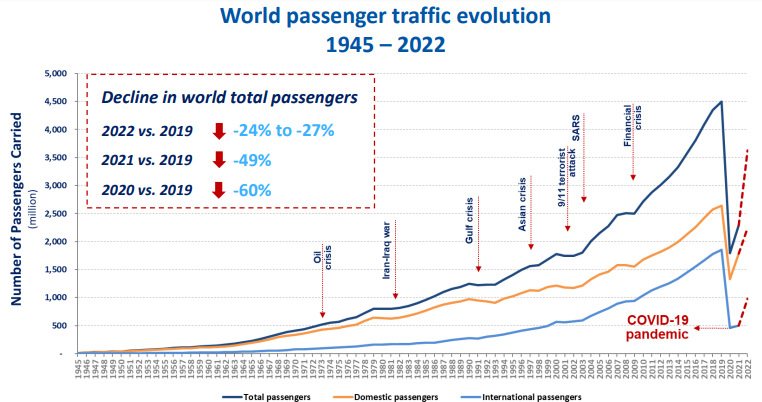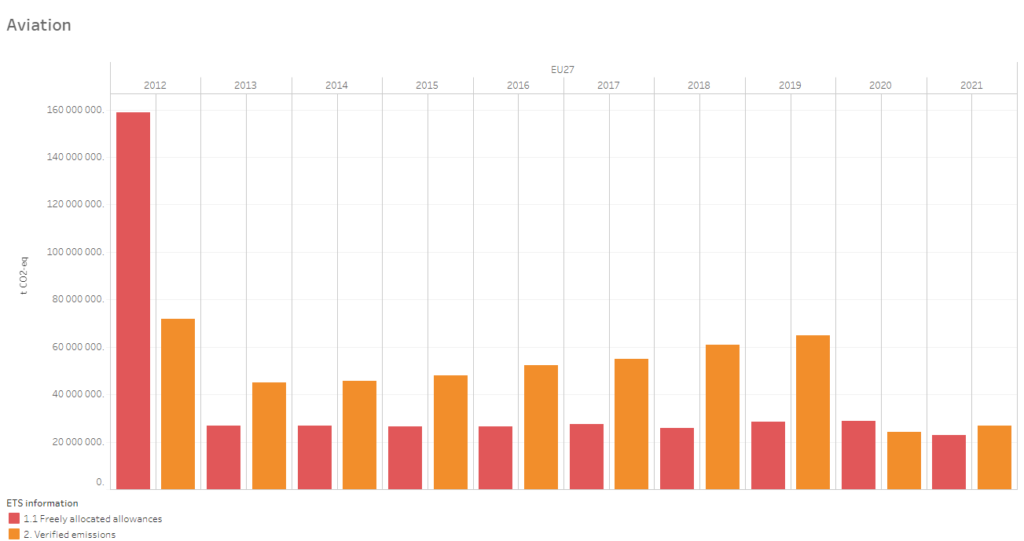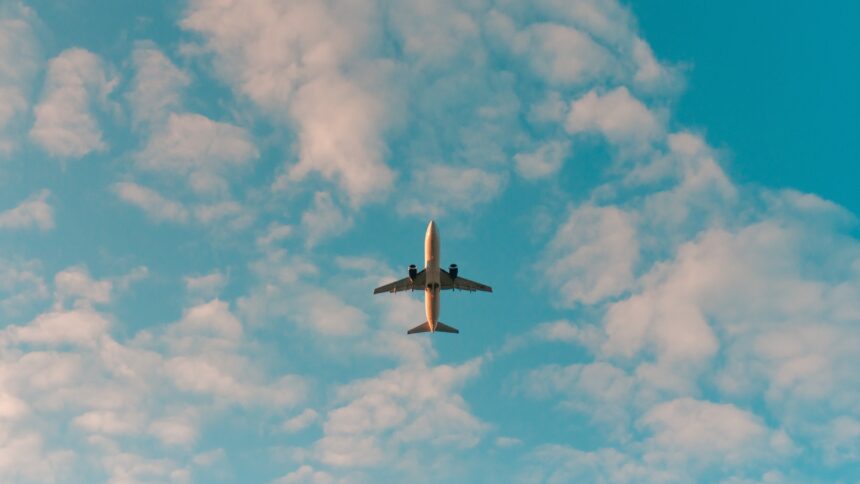A post by Jacopo Cammeo (Research Advisor for the project LIFE DICET)
By the end of 2019, Civil Aviation was one of the most rapidly flourishing sectors all over the world. In Europe, the number of flights grew by 80% over the period 1990-2018, and the European Aviation Safety Agency (EASA) projected an additional growth of 40% between 2018 and 2035.
In this context, the debate around the environmental impact of the civil aviation sector has arisen. Several states and international organisations, including United Nations (UN), International Panel Climate Change (IPCC), European Commission (EC), International Civil Aviation Organisation (ICAO), as well as academia and media repeatedly flagged the significant role of air travel in terms of greenhouse gases (GHG) emissions and its subsequent impact on climate change. For instance, EASA reported how CO2 and NOx emissions have skyrocketed at the European level over the last decades due to increased air traffic. Despite technological advances in aircraft fuel efficiency, the growing number of passengers on civil flights significantly increased CO2 emissions in the sector. In Europe, direct emissions from aviation accounted for almost 4% of total CO2 emissions in 2017 while in the US, emissions from domestic aviation accounted for more than 3% of the total. Globally, aviation was responsible for around 2,5% of GHG emissions and accounted for more than 12% of CO2 emissions from all transport sources. In the meantime, non-CO2 climate impacts of aviation, like emissions of oxides of nitrogen (NOx), soot particles, oxidised sulphur species, and water vapour, constantly arose.
The outbreak of the COVID-19 pandemic caused a drastic reduction in the number of flights operated in the last three years period (2020-2022) compared to 2019, with a relevant decrease in number of seats offered, passengers (with a moderate recovery of monthly passenger numbers for domestic and international travel in 2022), and operating revenues of companies. The effects of the pandemic on the aviation sector led to a temporary reduction in emissions of 64% in 2020 compared to 2019. According to the European Organisation for the Safety of Air Navigation, the 2019 emission level would not be reached before 2024. This offers an incredible opportunity to speed up the process of regulating emissions in the sector at the European and global levels.

In the early 2010s, ICAO made proposals on how to decarbonise the sector of aviation with the use of electro fuels (also called e-kerosene) and sustainable biofuels, with an optimisation of its operations (e.g. more sustainable and efficient flightpaths through the modernisation of air traffic management) and with technological improvements (e.g. investments in the electrification of planes). Other meaningful examples of such proposals include applying market-based measures to the flying sector, like an emission trading scheme.
This led to the development of the Carbon Offsetting and Reduction Scheme for International Aviation (CORSIA), a global market-based mechanism adopted in 2016 by ICAO to address CO2 emissions from international aviation. CORSIA, which includes monitoring emissions on all international routes, corresponds to the implementation of a global emissions compensation scheme developed through consensus among governments, industry, and international organisations. 115 countries (covering about 77% of all international aviation activity) have volunteered to join by 2023. CORSIA aims to “stabilise international civil aviation net CO2 emissions at 2019 levels, from 2021, using offsetting programs to compensate for their emissions by financing a reduction in emissions elsewhere” (ICAO, 2022). The scheme is implemented in three phases: a pilot phase (2021-2023), a first phase (2024-2026), and a second phase (2027-2035). Participation is voluntary for the first two phases (2021-2026).
Carbon pricing for aviation has already been in place in the EU. For the EC, market‑based measures should incentivise aviation to cut emissions since technological progress alone is insufficient to tackle the problem. Thus, GHG emissions from the sector have been covered in the EU Emissions Trading System (EU ETS) since 2012. The EU ETS helped reduce the aviation sector’s carbon footprint by around 17 million tonnes of CO2eq per year. Still, it did not bring a net decrease in emissions, as shown in the data collected by the European Environment Agency (2022).

In July 2021, the European Commission proposed to revise the ETS aviation rules as part of the Fit for 55 Package (FF55). The two main objectives of the revision are the contribution to the European Green Deal goal of reducing transport emissions by 90% by 2050 compared to 1990 levels and the support in implementing the CORSIA scheme, joined by all EU countries from the start.
Despite literature suggesting the rapid implementation of CORSIA was a necessary step towards a carbon neutral future, the negative economic impact of COVID-19 on aviation and the following amendment to the CORSIA design in June 2020 has slowed down the initiative. In this way, the coverage and environmental impact of CORSIA, which only tackles any post-2020 additional emission growth, remains low, whereas revising the EU ETS provision on all EU aviation emissions would have positive effects.
On the one hand, the EU ETS is a trustworthy and reliable mechanism that needs further strengthening measures. On the other hand, CORSIA still needs to become operational, and this implementation is related to the political will of the States, the effectiveness of national measures and the environmental integrity of the offsets used. A global sectorial emissions scheme is undoubtedly a promising idea to foster harmonised solutions to the super wicked problem of climate change. Still, its implementation is an ongoing process that has experienced some setbacks. In this regard, CORSIA should be considered as a complementary mechanism rather than a substitute instrument for ETSs. In addition, complementary EU initiatives to decarbonise aviation within the FF55 Package (e.g. proposal for a kerosene tax via the revision of the Energy Taxation Directive, ReFuelEU Aviation increasing the use of sustainable aviation fuels, Alternative Fuels Infrastructure Regulation revision for airports to secure clean electricity supply to aircraft) could be reinforced by the EU ETS reform, for example by recycling carbon revenues to finance such measures.
References:
- Maertens, S., Grimme, W., Scheelhaase, J., & Jung, M. (2019). Options to continue the EU ETS for aviation in a CORSIA-world. Sustainability, 11(20), 5703.
- Mai, D. T. T. (2021). Revising the EU ETS and CORSIA in times of the COVID-19 pandemic: challenges for reducing global aviation emissions. Climate Policy, 21(10), 1357-1367.
- Sharma, A., Jakhar, S. K., & Choi, T. M. (2021). Would CORSIA implementation bring carbon neutral growth in aviation? A case of US full-service carriers. Transportation Research Part D: Transport and Environment, 97, 102839.
The views and opinions expressed in this post are solely those of the author(s) and do not reflect those of the editors of the blog of the project LIFE DICET.

